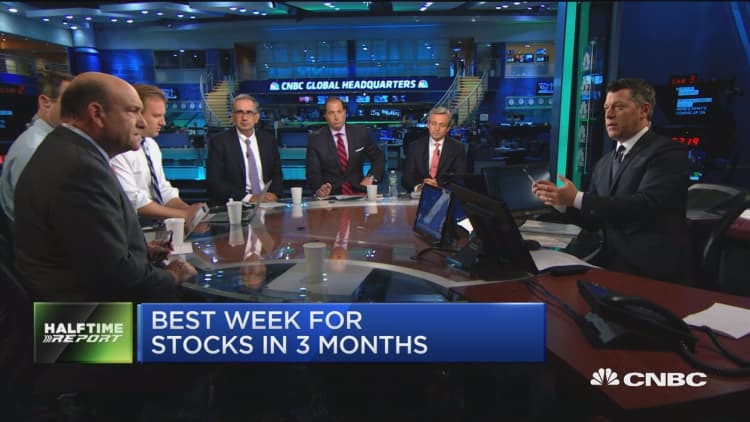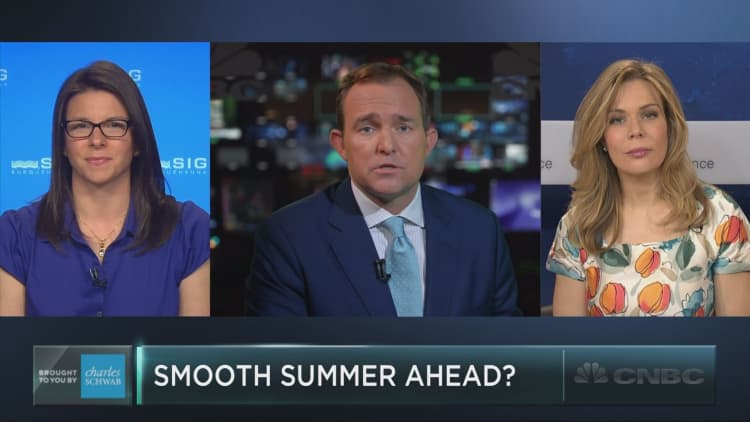
Data in the coming week should give a deep look into the U.S. economy and provide some important clues as to whether it's strong enough for the Fed to hike rates this summer.
From Friday's monthly jobs report to other data on inflation, manufacturing, the services sector and consumer, this four-day work week holds the last big blast of major reports ahead of the Fed's June 14 and 15 meeting.
"I think the debate in the next week is: 'Did the data give enough ammo for the Fed to go in June or July?'" said Art Hogan, chief market strategist at Wunderlich Securities. "I think we lean toward July, because there's too much at risk for them to step in front of the Brexit vote by eight days." Brexit is the U.K.'s vote June 23 on whether to leave the European Union. While the Fed has said this could complicate its decision, recent polling shows a split is less likely to be approved by U.K. voters.
Read MoreYellen: Rate hike probably appropriate in the coming months
Fed Chair Friday gave another boost to the view that the Fed could raise rates as soon as June, when she said an interest rate hike is probably appropriate in the coming months if data continue to improve. There are just a few Fed speakers in the week ahead, but Yellen will make a major speech on the economy the following week, on June 6.
In the past week, stocks sailed higher as markets seemed to become more comfortable with the idea that the Fed will soon raise interest rates for the second time since taking them to zero in 2008. The was up 2.3 percent to 2,099, its best week since March 4. The index is now perched just under 2,100, a key psychological level.
Treasury yields were higher on the week with the yielding 0.91 percent Friday afternoon. The dollar was also firmer, with the dollar index up 0.5 percent on the week. Both Brent and West Texas Intermediate oil futures cracked $50 this past week for the first time since October, and now energy traders are looking ahead to OPEC's meeting Thursday.

Fed funds futures Friday morning showed that the market was giving odds of 32 percent for a June rate hike and 64 percent for a July hike, according to data from Jefferies. The market has been upping the odds on June and July, as well as September, since the Fed minutes were released May 18 and indicated that the Fed would like to raise rates at its June meeting if the data are good enough. Fed officials, one after the other, have reinforced that a hike could come this summer, and markets have responded relatively calmly.
Citigroup credit strategists surveyed their clients and found that two-thirds expect the credit markets to remain steady or that spreads will get even get tighter if the Fed raises rates. But Bank of America Merrill Lynch equity strategists have another view of the stock market. They said in a note Friday that a rate hike could surprise stocks, and that hawkish industries, like banks, are still cheap, while the dovish sectors that weaken in rate hiking cycles are still expensive. That would include REITs, food products and utilities.
"I think the market moves are what's going to keep us on our toes," said Hogan. "So, now it's a shift back to the fundamentals and are the fundamentals good enough for the market to price in a July interest rate hike? It feels like it is."
Read MoreUS economy picking up steam—beyond the official data
The jobs number could be a turning point for the view on the Fed, though economists also point out that the PCE deflator, the Fed's preferred inflation measure, will also be important when it is released Tuesday. Inflation measures have been picking up, though the PCE has lagged them.
"I think the jobs number has the ability to push the expectations for the Fed in one direction or the other. I think it will come down more to the wages number than top line jobs," said Luke Tilley, chief economist at Wilmington Trust. He noted that jobs growth already had decelerated to 160,000 for April. Economists expect 161,000 nonfarm payrolls, an unemployment rate of 4.9 percent and an increase in average hourly wages of 0.2 percent, according to Thomson Reuters.
A low nonfarm payrolls number should not deter the Fed. "The long-term run is nowhere near 200,000. It's much closer to 100,000 that they need to accommodate people moving into the labor force," said Tilley.
The May employment report could be somewhat complicated by the fact that there were 35,000 Verizon workers on strike during the survey week for the report. Verizon said Friday it reached a settlement with its workers.
William Lee, Citigroup head of North America Economics, expects 140,000 nonfarm payrolls, and excluding the Verizon workers it would have been 175,000. He expects the Fed to hike rates in September.
In a note, he said the data in the coming week could help mend the split between hawks and doves on the Federal Open Market Committee. He said the rift appears to have prevented the comments about a June rate hike from being mentioned in their post-meeting statement. The release of the comment in the minutes was a surprise to markets and Fed watchers, and since then Fed officials have been pushing the idea of a summer hike.
So this week's data will be key ahead of the Fed's June meeting, as will the retail sales number June 14. "Essentially we need everything that supports a strong consumer, and if anything comes in that shows that the consumer is crapping out, that's the thing I'm looking for the most. That's the thing the Fed is looking for. They're looking to see that the expansion they're looking for is consumer led, and solidly consumer led," Lee said. "The durable goods number confirmed there's no business investment … right now it's flattish but nowhere near that great."
As for OPEC, the meeting is not expected to result in any change of production but it could be contentious. The last meeting of oil producers was in Doha in April, and included non-OPEC members. As it had been warning, Saudi Arabia would not agree to a deal to freeze production that did not include Iran.
"Not much of anything has really changed since Doha. I think it would be hard for Iran and the Saudis to get along, and with prices the way they are, I don't see that they have much incentive," said Michael Wittner, global head of oil research at Societe Generale.
Wittner said oil could drift lower ahead of the meeting of the Organization of the Petroleum Exporting Countries. WTI futures ended Friday at $49.33 per barrel.
What to watch
Monday
Memorial Day holiday
Tuesday
8:30 a.m. Personal income and spending
9 a.m. S&P/Case-Shiller
9:45 a.m. Chicago PMI
10 a.m. Consumer confidence
Wednesday
May vehicle sales
9:45 a.m. Manufacturing PMI
10 a.m. ISM manufacturing, construction spending
2 p.m. Beige book
Read MoreSummer rate hike odds pop after Yellen comments
Thursday
7:45 a.m. European Central Bank rate decision
8:15 a.m. ADP employment
8:30 a.m. Initial claims; ECB President Mario Draghi press briefing
1 p.m. Dallas Fed President Rob Kaplan
Friday
3:45 a.m. Chicago Fed President Charles Evans in London
8:30 a.m. Employment report; international trade
9:45 a.m. Services PMI
10 a.m. ISM nonmanufacturing, factory orders
12:30 p.m. Fed Governor Lael Brainard at Council on Foreign Relations, DC
Saturday
3 a.m. Cleveland Fed President Loretta Mester


